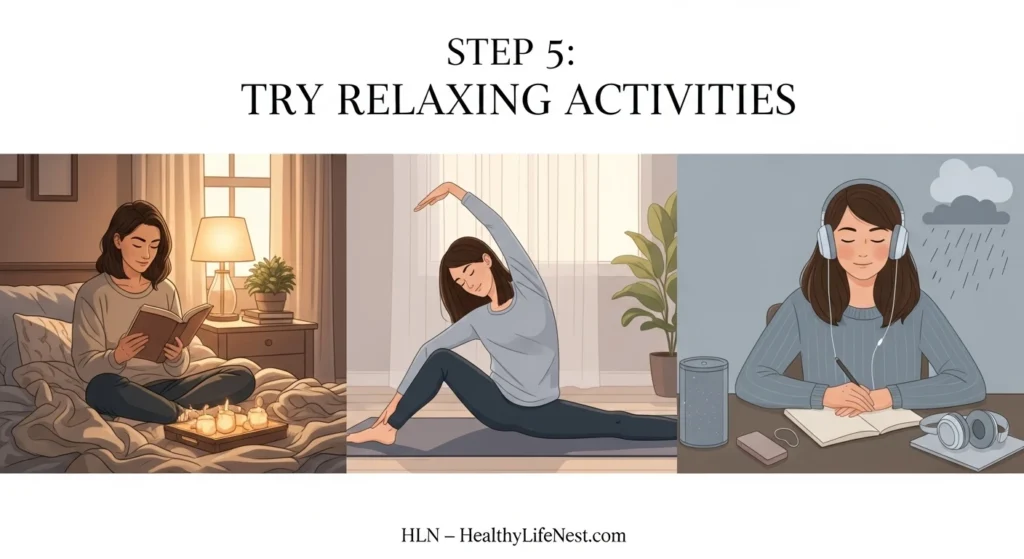Night Routine: Simple Steps for Better Sleep
A night routine is a set of calming activities you do before bed to help you relax and sleep better. It’s like a signal to your body that it’s time to wind down. For Pinterest users in Europe and the US, who often juggle busy lives, a thoughtful night routine can make a big difference in feeling rested and refreshed. This guide shares easy, practical steps to create a night routine that works for you, backed by science and tailored for real life.
Why a Night Routine Matters
Your body has a natural rhythm that controls when you feel sleepy or awake. A consistent night routine helps align this rhythm, making it easier to fall asleep and wake up feeling good. Good sleep boosts your mood, energy, and health. Plus, a night routine can be a cozy way to end your day, giving you a moment to care for yourself.
Step 1: Pick a Bedtime and Stick to It
Choose a bedtime that fits your schedule and gives you 7-9 hours of sleep. For example, if you need to wake up at 7 AM, aim to be in bed by 10 or 11 PM. Consistency is key—even on weekends. This trains your brain to feel sleepy at the same time every night.
Tips for Setting a Bedtime:
- Decide your wake-up time first, then count backward 8-9 hours.
- Set a phone reminder 30 minutes before bedtime to start your routine.
- Stick to the same bedtime daily for at least two weeks to build the habit.
Step 2: Create a Tech-Free Zone
Screens from phones, tablets, or TVs emit blue light that can trick your brain into staying awake. Cutting out screens an hour before bed helps your body produce melatonin, the hormone that makes you sleepy.
How to Disconnect:
- Put your phone on “Do Not Disturb” mode or leave it in another room.
- Try a red-light filter on your phone if you must use it.
- Replace screen time with calming activities like reading or stretching.
| Screen Time vs. Sleep | Impact |
|---|---|
| Using screens before bed | Delays melatonin, harder to fall asleep |
| No screens 1 hour before | Easier to relax, better sleep quality |
Step 3: Enjoy a Light Snack or Tea
Going to bed too full or too hungry can keep you awake. A small, healthy snack or a soothing drink can calm your stomach and mind.
Sleep-Friendly Snacks and Drinks:
- A handful of almonds or walnuts (rich in magnesium).
- A banana or kiwi (natural sleep boosters).
- Herbal tea like chamomile or peppermint (caffeine-free).
Quick Recipe: Chamomile Bedtime Tea
- Boil water and steep a chamomile tea bag for 5 minutes.
- Add a teaspoon of honey for sweetness (optional).
- Sip slowly while relaxing.
Step 4: Take a Warm Shower or Bath
A warm shower or bath 1-2 hours before bed mimics your body’s natural temperature drop at night, signaling it’s time to sleep. It’s also a relaxing way to wash away the day’s stress.
Bath Time Ideas:
- Add a few drops of lavender essential oil for extra calm.
- Keep the lights dim to create a spa-like vibe.
- Spend 10-15 minutes soaking or showering to unwind.
Step 5: Try Relaxing Activities

image
Calming activities help shift your mind from the day’s hustle to a peaceful state. Choose one or two that feel good to you.
Relaxing Activities to Try:
- Reading: Pick a light, non-thrilling book, like a cozy novel or poetry.
- Gentle Stretching: Do 5-10 minutes of yoga or simple stretches.
- Journaling: Write down three things you’re grateful for or tomorrow’s to-do list.
- Listening to Sounds: Play soft music, white noise, or nature sounds like rain.
| Activity | Benefit |
|---|---|
| Reading | Calms the mind, reduces stress |
| Stretching | Relaxes muscles, prevents cramps |
| Journaling | Clears mental clutter, boosts gratitude |
| Nature Sounds | Masks noise, promotes relaxation |
Step 6: Set Up Your Sleep Space

Your bedroom should feel like a cozy, sleep-friendly haven. A few small tweaks can make it easier to drift off.
How to Prep Your Bedroom:
- Keep the room cool (65-68°F or 18-20°C).
- Use blackout curtains or a sleep mask to block light.
- Try a diffuser with calming scents like lavender or cedarwood.
- Make your bed inviting with clean sheets and comfy pajamas.
Step 7: Practice Deep Breathing
Deep breathing is a simple way to calm your mind and body. It lowers stress and helps you feel sleepy.
Easy Breathing Exercise:
- Sit or lie down comfortably.
- Inhale slowly through your nose for 5 seconds.
- Hold your breath for 3 seconds.
- Exhale through your mouth for 7 seconds.
- Repeat 5-10 times.
Common Night Routine Mistakes to Avoid

- Staying on screens too late: Aim to stop at least an hour before bed.
- Drinking caffeine or alcohol: These can disrupt your sleep cycle.
- Overloading your routine: Start with 1-2 habits and build slowly.
- Inconsistent bedtimes: Changing your schedule too much confuses your body.
Sample Night Routine (30-60 Minutes)
| Time | Activity |
|---|---|
| 9:30 PM | Turn off screens, set phone aside |
| 9:35 PM | Sip chamomile tea, eat a light snack |
| 9:45 PM | Take a warm shower with lavender oil |
| 10:00 PM | Do 5 minutes of stretching or yoga |
| 10:10 PM | Write in a journal or read a book |
| 10:20 PM | Set up bedroom (dim lights, diffuser) |
| 10:30 PM | Practice deep breathing, get into bed |
Final Thoughts
A night routine doesn’t have to be complicated. Start small, with one or two steps, and make it your own. Over time, you’ll notice better sleep, less stress, and more energy for your day. Experiment with these ideas, and pin your favorite tips to share with others!




